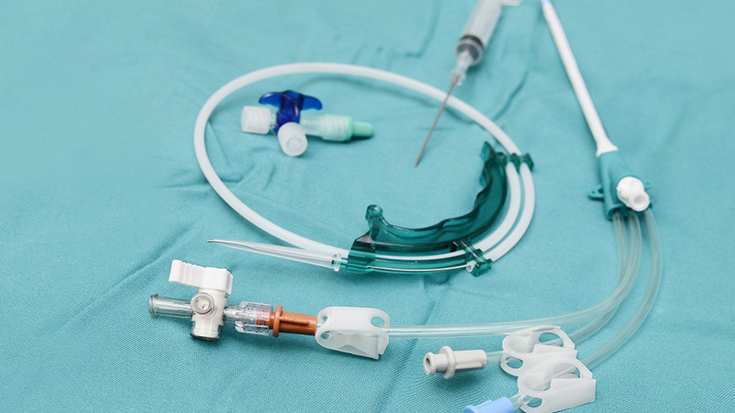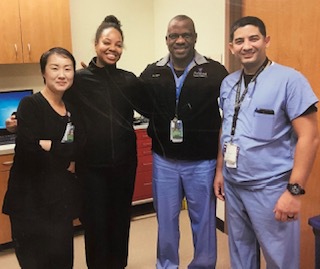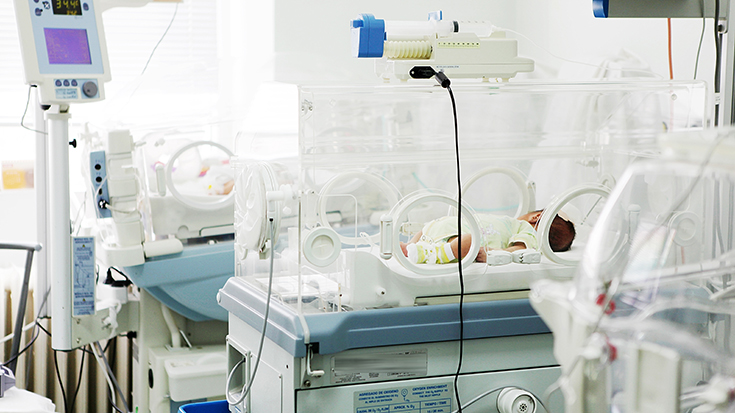
In most places around the country, vascular access programs are the sole purview of nursing. But that is changing in some areas, and Texas is one state that’s leading the way.
Several years ago, the state licensing board confirmed that vascular access would fall under the respiratory therapist scope of practice. Since then, more and more RT departments in Texas have gotten involved in the service.
 The Vascular Access Team at Parkland Memorial Hospital includes, from left to right, Angela Park, RRT, Tavia Grant, RRT, Ike Ugoh, RRT, and Tamer Elberry, RRT.
The Vascular Access Team at Parkland Memorial Hospital includes, from left to right, Angela Park, RRT, Tavia Grant, RRT, Ike Ugoh, RRT, and Tamer Elberry, RRT.Edward Best, RRT, director of respiratory care services at the Parkland Health & Hospital System in Dallas, TX, and Kenneth Smith, BS, CRT, director of rehabilitation, respiratory therapy, and wound care services at Rio Grande Regional Hospital in McAllen, TX, both have robust vascular access programs in place that use RTs along with nurses to insert PICC lines and more.
Driven by need
Smith’s department began inserting PICC lines and midlines in August of 2017, right around the time that the Texas Medical Board provided its guidance on the use of RTs for these services.
“Shortly after that, the management of vascular insertions was moved from nursing to the RT department,” he said.
The move increased the efficiency of the program.
“Previously, the hospital had two critical care nurses that inserted lines,” explained Smith. “Having just two nurses to insert lines at a 320-bed hospital led to increased turnaround times and also created some difficulty in the length of stay when patients required a line insertion in order to be discharged home.”
RT involvement in the vascular access program at Parkland was born out of a decision by the chief CRNA and manager of the Vascular Access Team (VAT), says Best. They presented a proposal to the RT department director in 2018, making a case for the inclusion of RTs on the team.
Like at Rio Grande, the problem lies in the lack of trained nurses to do the procedures.
“At that time, the Vascular Access Team consisted of four registered nurses to cover Parkland Memorial Hospital’s nearly 900 beds,” Best said. “Initially, the PICC and midline service was only available during the day shift. This caused a delay in PICC and midline placement, and in some instances increased length of stay for patients.”
Initial concerns about allowing RTs to perform the service were quickly alleviated by the Texas Medical Board’s guidance on the issue.
Selecting staff
Both of these departments gave careful consideration to which therapists would be trained to perform the vascular access procedures. At Rio Grande, Smith says the initial thought was to use supervisors, the clinical coordinator, and an educator to perform the insertions.
“We made a conscious decision not to train all staff due to competency constraints,” he said.
It quickly became evident, though, that the supervisors — who also carry patient assignments — would not have the time to devote to these procedures, which can take anywhere from 30 minutes to an hour and a half and require sterile technique, including draping the patients.
They ultimately went with an RT who works with the emergency department in providing post-visit services to decrease repeat visits for respiratory issues and the therapist who handles the department’s smoking cessation, asthma education, and COPD education services.
Today they have four RTs on the team, along with one critical care nurse, and are looking to add another nurse or two PRN therapists to keep up with demand. Everyone on the team must have 30 successful insertions to maintain competency.
At Parkland, Best decided to open up the program to staff therapists to give everyone interested the chance to participate. The criteria, however, were stiff. To qualify, therapists had to have multiple years of critical care experience, proven dependability, and a willingness to work on the night shift since three of the four RTs assigned to the program were to be delegated to nights.
Selecting therapists for the team wasn’t easy since many of them met the criteria.
“The selections were made during a respiratory care leadership group meeting,” Best said.
Today the team has expanded to include six RNs as well.
Extensive training
The training that these therapists go through is extensive. At Parkland, it’s a 12-week program, with the first four weeks consisting of classroom time with the vendor, online modules, and lab training. During the next six to eight weeks, the trainee is paired with an experienced team member, where they learn about the various procedures and protocols of PICC and midline placements.
While no set number of placements was required to prove competency, Best says most of the RTs who underwent the initial training performed about 50 before receiving final approval.
“All of the RCPs had to be fully signed off by their preceptors before they were released to perform line insertions by themselves,” he emphasized.
Smith says the RTs on his team went through a training program offered by their vendor. An 8.5-hour online course covered selection, care, maintenance, and insertion of lines. A three-day didactic course followed, and then a clinical specialist from the vendor spent a week in the hospital to provide the initial competency certification for the staff.
“Our clinical educator underwent some additional training with the clinical specialist and was deemed competent to perform the annual competencies as well as train new staff to insert lines,” he said. ”If needed, our vendor will return and provide the training for new staff.”
Benefits abound
Best and Smith say their departments have reaped many benefits from their participation in vascular access.
“Offering PICC line and midline insertions are enhancing our exposure as multi-skilled bedside clinicians and allowing the respiratory therapists to practice at the higher end of their license,” Best said. “During the peak of COVID-19 hospitalizations, respiratory therapists who were members of VAT were able to function in the COVID-19 ICUs as respiratory therapists with the added skill set of inserting PICC lines when needed.”
Using RTs for the service has also enabled the hospital to expand VAT service availability to 24/7, had a positive effect on patient satisfaction by reducing length of stay, increased provider satisfaction by providing care in a more timely manner, and increased employee satisfaction in the RT department.
Most importantly, RTs were added to the team without any increase in the CLABSI rate, despite the increased volume of procedures.
Similar outcomes have been seen in Smith’s hospital. Length of stay has improved, patients are happy they can be discharged sooner, and physicians love the shorter turnaround times from order to insertion. After the initial learning curve, the RTs’ success rate with insertions matched that of nurses, and there has been no increase in the CLABSI rate related to insertions here either.
Smith says his department has performance goals related to vascular access, and they have consistently met the 12-hour turnaround time and are working to lower it to eight hours. They are also on track to meet the goal for a Monday-Friday service and are working to insert midlines in place of central lines for patients who qualify for a midline.
“Our ratio of midlines to PICC lines is now about 80% midline and 20% PICC,” he said. “When we began, it was 60/40.”
While he admits there are challenges to getting a team like this up and running — for example, communication with the nursing team and productivity took a while to figure out — he believes it is well worth all the work that goes into it.
“Any time you increase the exposure of your team to nurses and physicians outside of the critical care areas, you are representing the practice of respiratory care,” he said. “The team inserting the lines definitely enjoyed taking on a new challenge and excelling at it. We have many staff that are interested in participating on the team.”
Good advice
What advice do these two managers have for their fellow RT managers who may be interested in having their RTs perform vascular access? Here are their recommendations —
Good relationships with senior leadership and leaders in other disciplines is crucial to the success of taking on new roles such as this. Respiratory care leaders must be assertive and willing to take on new challenges. RCPs must continue to focus on maintaining skills, dependability, accountability, and professionalism. All eyes will be on your department. — Edward Best
The communication and relationship with your chief nursing executive and unit directors are key. There may always be some pushback from the team that may feel you are encroaching on a traditional nursing procedure. Being aware that this may happen and having tactics ready to address it will increase your chance of success. Many facilities have outsourced the procedure due to internal staffing issues. If this is the case, a well-presented financial argument will help you prevail. Of course, if you are challenged with staffing issues that are as or more severe than your nursing counterparts, you may want to think about taking on this role. We have been in the unusual position (pre-COVID) of excellent respiratory therapy staffing so that when the need arose, we were able to address it. We also had very good support from our central line vendor, who really made the process much easier to navigate and implement. — Kenneth Smith
Something to consider
Vascular access may not be suitable for every RT department. Still, if you have available staff to run the program and the support of your nurses, physicians, and administrators, it could be a great addition to the line-up of services you already provide.
Email newsroom@aarc.org with questions or comments, we’d love to hear from you.















